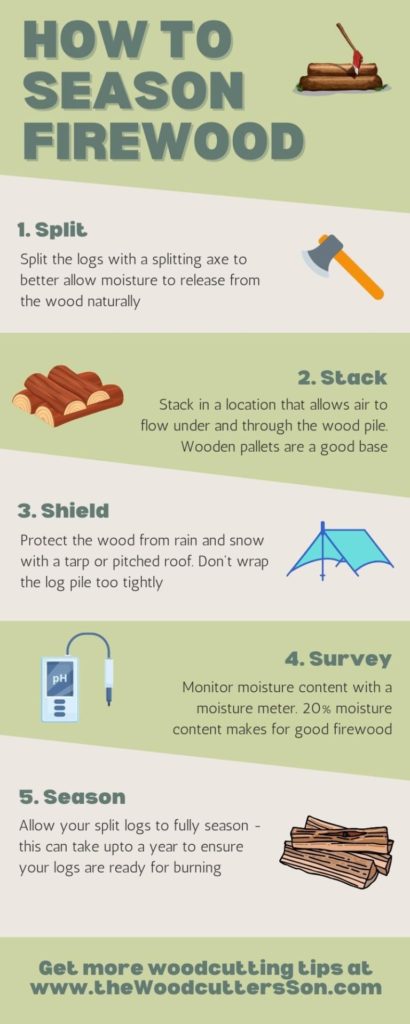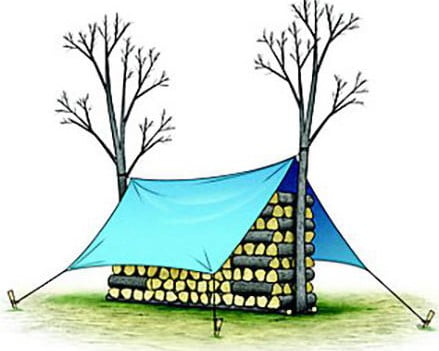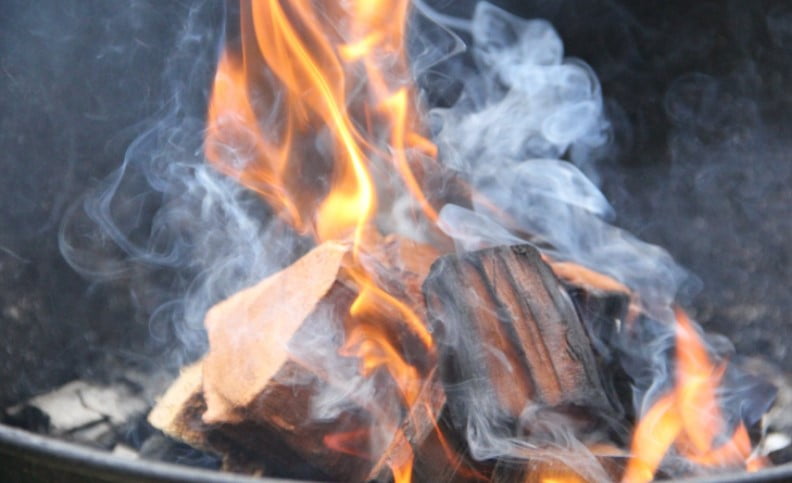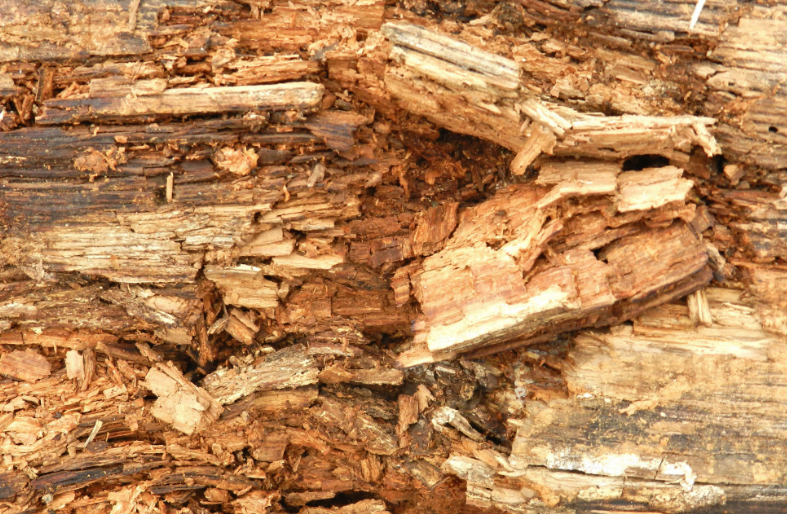Post Updated: 27 Feb 2023
If you’re lucky enough to live in an area that is warm and dry, and rain is infrequent then an uncovered wood pile is perfectly ok. In fact leaving your wood pile uncovered is the IDEAL way to dry your wood.
The occasional downpour is not going to be a huge problem and the wood will soon dry out in a few days again. Is it ok to leave firewood uncovered? As we can’t predict the weather, it makes sense to cover your woodpile as a precaution.
There are arguments for and against covering stacked firewood but it’s universally agreed that it needs to be kept in a place where it is protected from excess rain/moisture and it is stacked in a way that promotes air flow through the stack.
Related Article: How To Keep Firewood Dry – Without A Woodshed
TABLE OF CONTENTS:
Straight to the point – How to season firewood
- Split the logs with a splitting axe to allow moisture to release naturally
- Stack in a location that allows air to flow under and through the wood pile
- Protect the wood from rain and snow with a tarp or pitched roof
- Monitor moisture content with a moisture meter
How to season firewood [Infographic]

Wood Seasoning Tips
The best way to cover firewood outside
If you’ve decided to cover your wood stack you should avoid the common mistake that I see time and time again. Usually people take a tarp and fasten it down on top of the stack leaving the sides open.
This is not the best option because the moisture released from the wood goes upwards – just like the steam from a pot of boiling water – hits the tarp, then drips back down onto the wood.
A pitched roof is so much more effective in helping the evaporated moisture away from the stack.

This simple setup is the tried-and-tested best way to cover a stack of firewood outside – Air can circulate freely around the whole thing while any moisture released from the wood is diverted away by the angle of the tarp.
If you don’t have trees to tie off your tarp, a couple of sturdy posts either side of your stack will do the job. The important thing is to keep the tarp off the top of the stack and pitched to assist the runoff of moisture.
Tip: Use simple wooden pallets as a base for your firewood to ensure air flow underneath
How to check the moisture content of your firewood
It’s always a good idea to check the moisture content of your wood throughout the seasoning process to ensure adequate moisture evaporation is taking place. You can do this by means of a simple Wood Moisture Meter available on Amazon for around $30.

A moisture meter is great way of assessing whether your firewood is ready to burn and can give you insight into the seasoning efficiency of your wood stack position or location.
You may find one side in particular seems to dry out first so you can use this to determine why and make adjustments of your wood storage if necessary.
Wood Seasoning Q&A
Is it OK for firewood to get wet?
The most important factor for drying out wood is adequate air flow around and through the stack. This is achieved by proper stacking of the split logs to begin with. Your wood should be raised 5 inches off the ground and stacked in such a way that it can stand alone – not just thrown in a pile.
Clearly, it does the wood no good sitting under 2 feet of snow all winter or getting subjected to daily torrential rain, so some common sense should be applied given whatever state or country you live in.
The occasional shower will not stop your firewood drying out. The worst thing you could do is wrap a stack of wood in a tarp for a year – the moisture that is released from the wood has nowhere to go, so the wood will never dry out.
With properly stacked firewood, plenty of sunshine and a stiff breeze the occasional downpour is nothing to worry about. Is it ok to leave firewood uncovered?
Sure, as long as your wood is stacked correctly allowing adequate air to circulate, the occasional bit of rainfall is not an issue.
Can you burn wet or ‘green’ wood?
Besides the fact that freshly cut or ‘green’ wood does not burn easily, it produces a lot more smoke due and burns cooler due to the high moisture content.
Instead of your fire emitting a blazing heat, all the energy is being used to burn off the moisture of the green wood, so it doesn’t make for a nice warm fire and certainly should not be used to heat your home.

Burning unseasoned wood in a home fireplace can have disastrous results due to the water vapor and other gases and particles going up the chimney and eventually cooling to form a tarry substance that can lead to chimney fires.
In an outdoor environment this is obviously not an issue – if you throw enough dry wood on to maintain the intensity of the fire, you can add some green wood as well. Just be prepared for plenty smoke, sizzling and popping!
The simple answer is to properly season your firewood prior to burning.
How long does it take to season firewood?
Freshly cut wood contains almost half its weight in moisture. This doesn’t make it suitable for burning efficiently – you want a moisture content of around 20 percent before it is suitable for your fireplace or stove.
Depending of the type of wood, the seasoning process can take anywhere from 6 months up to 2 years. Softer wood will take less time, while hard wood takes longer to dry out, but this will vary depending on a few important factors: the initial moisture content, how well the wood is stacked and covered, and the climate and weather in your location.
Related Article: How to build a shed for wood storage
Is it OK to stack firewood next to your house?
A stack of firewood is like Disneyland for rodents and insects. Unless you’re planning on taking in new lodgers I strongly advise keeping your firewood well away from your house – 30 feet is the recommended distance from pest control specialists.

Aside from rats, your main concern is things like termites and carpenter ants. They just love wood, and if these get into your home they can do real damage so if you can, stack your logs far away from your home.
Will firewood dry indoors?
Split logs dry out over time by releasing moisture held within the wood fibres. Around 35 – 45% of the weight of freshly cut logs is moisture content which is why we dry out or ‘season’ the wood – it makes it easier to burn.
Although firewood will eventually dry out if kept indoors, you should never store newly cut wood in your home. The presence of moisture, bark and sap is what bug and critters are attracted to, and green wood will be host to hoards of critters that you don’t want roaming around your house.
The reason we keep firewood outside is to ensure moisture, sap, bugs and critters are removed BEFORE we take it into our homes.
Can firewood go bad?
Prolonged exposure to moisture and damp is the thing that will ruin your firewood – which is why you should make sure it is kept in a dry, well-ventilated environment.

When wood is properly seasoned, the moisture contained within is allowed to evaporate over time making the wood suitable for burning.
If wood is stored in the correct manner – off the ground, protected from rain, and allowed to air out, it can be left for many years without degradation of the wood.
Incorrectly stored wood that is exposed to prolonged moisture and damp will eventually rot and become useless.
Can firewood be too dry?
A 20 percent moisture content for firewood is about the optimum range to get an efficient fire in terms of heat and sustainability. The kindling used to START a fire is typically much drier and will burn easily and quickly.
If all your logs were this dry you would be burning a full cord of wood every night!
Can you burn rotted wood?
Sure. But it’s not recommended. There really isn’t much value in burning rotten wood – except maybe in the firepit outside just to get rid of it!
I used to collect some dead branches from the forest to use as kindling for a firepit night at the weekends. It burns quickly but smokes like hell and smells bad – so I stopped doing that.
Can you bake firewood to dry it out?
Those bags of kiln-dried pine logs you find at gas stations are exactly that – baked in a kiln to dry it out. If you have an oven big enough – and a wife willing to let you cram it full of wet wood, go for it!
On reflection though, it’s much easier to dry your wood by stacking it correctly and leaving it outdoor for a season or two. This will allow you to dry out your firewood AND eat home cooked meals at the same time!
Conclusion
Proper seasoning for a stack of split logs is the tried-and-tested way of ensuring you have a good store of healthy firewood. But is it ok to leave firewood uncovered?.. Probably not in most situations.
Unless you live somewhere that has year-round sunshine and minimal rainfall, it is always best to air on the side of caution and cover your firewood with a simple pitched tarp to protect the wood from the elements.
Depending on your location it is usually necessary to have some kind of cover to protect it from prolonged rainfall as this will obviously slow the drying process, however it is far more important to ensure your firewood is stacked and positioned correctly to promote good air flow below, around and above.

Leave a Reply